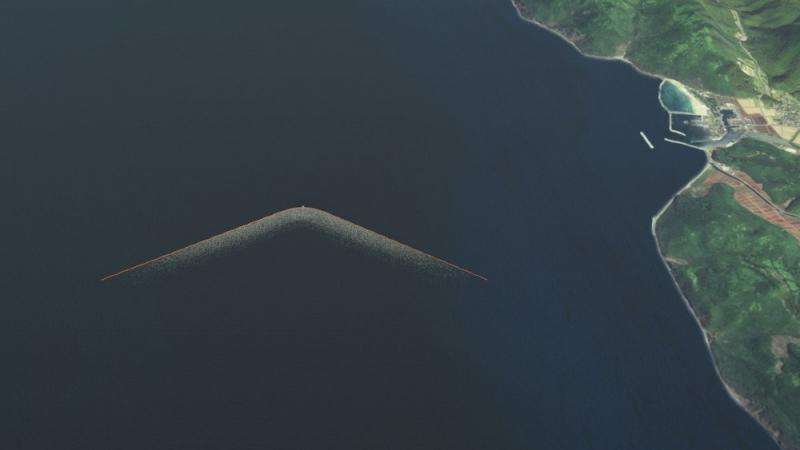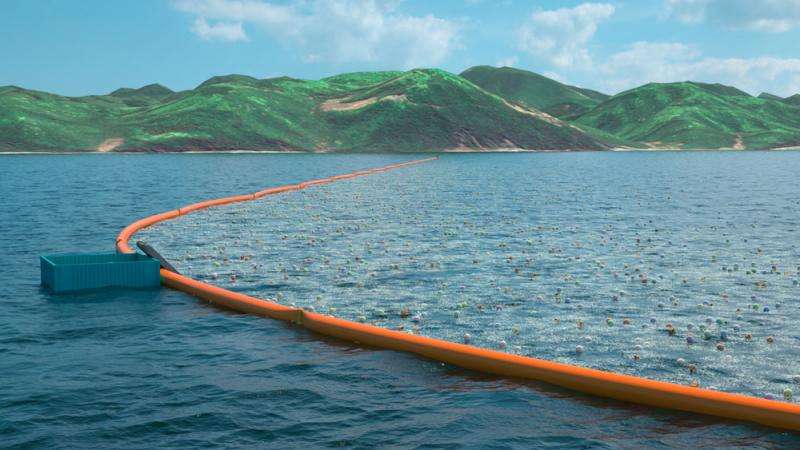June 3, 2015 weblog
Ocean plastic cleanup team plan 2016 system launch

Throw-away package wraps, bottles, sandwich wrappings, carrier bags—they all contribute to a sense of hopelessness when one sees the mess of plastic in the ocean thanks to shocking pictures confirming the mess we're in. Thinkers who care and refuse to give up are working out a plan that is not only feasible but now ready to launch.
The Ocean Cleanup is the simple name of the initiative. The first phase of their cleaning system will be deployed next year. The system will span 2000 meters as the first operational pilot array in coastal waters. The announcement was made at the Seoul Digital Forum in South Korea. The deployment under consideration is in waters between Japan and South Korea. The system will be in operation for at least two years; the goal would be to catch plastic pollution before it reached the shores of Tsushima island. In the case of that island, approximately one cubic meter of pollution per person is washed up each year.
The Ocean Cleanup is an undertaking that involves a method to clean the oceans' gyres of plastic, using the currents to advantage.
As The Guardian explained, around the globe, much of the plastic rubbish accumulates in large ocean gyres, circular currents churning up plastics in a set area.
In June last year, Boyan Slat, then 19 years old, unveiled results indicating his concept for an ocean cleanup was feasible. A team of 100 volunteering scientists and engineers led to the 2014 study confirming the passive system was feasible.
How it works: As the team's site argued, "Why move through the oceans, if the oceans can move through you?" Instead of going after the plastic using boats and nets, The Ocean Cleanup is to use long floating barriers, letting the natural movement of ocean currents passively concentrate the plastic itself.
"Virtually all of the current flows underneath these booms, taking away all (neutrally buoyant) sea life, preventing by-catch, while the lighter-than-water plastic collects in front of the floating barrier," according to the team's site.
"The scalable array of floating barriers, attached to the seabed, is designed for large-magnitude deployment, covering millions of square kilometers without moving a centimeter."
The team said the deployment marks a milestone in their longer-term mission to tackle the removal of plastic pollution from the world's oceans. In five years, for example, after a series of deployments of increasing scale, The Ocean Cleanup intends to deploy a 100km-long system to clean up about half the Great Pacific Garbage Patch, between Hawaii and California.
Their method is far cheaper than conventional methods, they claimed. "Using vessels and nets to collect the plastic from one garbage patch would take about 79,000 years and tens of billions of dollars," according to the site. Their long floating barriers will let ocean currents concentrate the plastic itself.
Millions of tons of plastic have entered the oceans; plastic pollution claims the lives of seabirds and marine mammals in great numbers. As for human health implications, "Toxic chemicals (including PCBs and DDTs) are adsorbed by the plastic, increasing the concentration a million times."

The Ocean Cleanup effort's founder and CEO is 20 years old, Boyan Slat. "Not only will this first cleanup array contribute to cleaner waters and coasts but it simultaneously is an essential step towards our goal of cleaning up the Great Pacific Garbage Patch," said Slat.
What is more, The Ocean Cleanup plans to develop spinoffs of its "passive collection" technology for implementation in river deltas and other waterways that transport plastic to the oceans.
The Ocean Cleanup team has about 100 people, with competencies in engineering, physical oceanography, ecology, finance, maritime law, processing and recycling.
The Guardian last year said over five trillion pieces of plastic were floating in our oceans, according to data collected by scientists from the US, France, Chile, Australia and New Zealand.
More information: www.theoceancleanup.com/blog/s … eployed-in-2016.html
© 2015 Tech Xplore













